Geoffrey Bawa
Deshamanya Geoffrey Manning Bawa, FRIBA (23 July 1919 – 27 May 2003) was a Sri Lankan architect. He was among the most influential Asian architects of his generation. He is the principal force behind what is today known globally as "tropical modernism".[1][2][3]
"It's no exaggeration to say that architect Geoffrey Bawa transformed the look of South-East Asia. And yet what he did is so subtle that we almost take it for granted today. In short, Bawa-tailored modern buildings to a specific environment. It hardly seems revolutionary and yet no one else had done anything like it in the region."[4]
Geoffrey Bawa | |
|---|---|
.jpg.webp) | |
| Born | Geoffrey Manning Bawa 23 July 1919 |
| Died | 27 May 2003 (aged 83) |
| Nationality | Sri Lankan |
| Alma mater | St Catharine's College, Cambridge Royal College, Colombo |
| Occupation | Architect |
| Awards | Aga Khan Special Chairman’s Award See below |
| Practice | Edwards, Reid and Begg Geoffrey Bawa Associates |
| Buildings | Sri Lankan Parliament Building University of Ruhuna Heritance Kandalama Hotel |
Early life
Geoffrey Bawa was born in Colombo on 23 July 1919,[5] the youngest of two sons to Justice Benjamin William Bawa, a wealthy and successful Muslim lawyer of Sri Lankan and European parentage,[6] and Bertha Marianne née Schrader, of mixed German, Scottish and Sinhalese descent.[7][8] His older brother, Bevis (1909–1992), became a renowned landscape architect.
Education
He was educated at Royal College, Colombo after which he studied English and Law, 1938, at St Catharine's College, Cambridge gaining a BA (English Literature Tripos) and went on to study law at Middle Temple, London becoming a Barrister in 1944.[5] Returning to Ceylon, after World War II, he worked for a Colombo law firm. After the death of his mother, he left the profession and soon left in 1946 to travel for two years, going to the Far East, across the United States, and finally to Europe and almost settling in Italy.[9] By the time he was 28 years old, he had spent a third of his life away from Sri Lanka. During his time in Italy, he planned to buy a villa and settle down, but that did not happen, and by 1948 he had returned to Sri Lanka. Bawa bought an abandoned rubber estate on the south-west coast of the island between Colombo and Galle at Lunuganga, planning to create an Italian garden from a tropical wilderness. However, he soon found that his ideas were compromised by his lack of technical knowledge. In 1951, he was apprenticed to H. H. Reid, the sole surviving partner of the Colombo architectural practice Edwards, Reid and Begg.[5] In 1952 Reid died, but Bawa still aspired to a career in architecture, so he returned to England, after spending a year at Cambridge, he enrolled as a student at the Architectural Association in London. There he gained a Diploma in Architecture by 1956 and in the following year he became an Associate of the Royal Institute of British Architects. To this day he is remembered as the tallest, oldest, and most outspoken student of his generation at AA. In 1957, at the age of 38 he returned to Sri Lanka qualified as an architect to take over what was left of Reid's practice.[10]
Career in architecture
Returning to Ceylon, he became a partner of Messrs. Edwards, Reid and Begg, Colombo in 1958. In 1959, Danish architect Ulrik Plesner joined the firm, and the two designed many buildings together in their distinct style, sometimes called "tropical modernism."[5]
Like the Maurice Talvande, Count de Mauny Talvande at Taprobane Island, the impetus for much of their work was the desire to create private arcadias within it.[11] Bawa's architecture is at one with the land: inside and outside blend seamlessly, and it is designed for the maximum pleasure of its inhabitants. He was influenced by colonial and traditional Ceylonese architecture, and the role of water in it, but rejected both the idea of regionalism and the imposition of preconceived forms onto a site.[12]
"Bawa's portfolio of work included religious, social, cultural, educational, governmental, commercial and residential buildings, and in each of these areas he established a canon of new prototypes. Early experiments in what was known as tropical modernism were tempered by a growing interest in the traditional architecture and building materials of Sri Lanka.
This led to the development of an architecture that was a blend of both modern and traditional, of east and west, of formal and picturesque, that broke down the barriers between inside and outside, between building and landscape, and that offered a blueprint for new ways to live and work in a tropical city."[13]
Plesner left the island in 1967.[14] Bawa became an Associate of the Sri Lanka Institute of Architects in 1960. An ensuing close association with a coterie of like-minded artists and designers, including Ena de Silva, Barbara Sansoni and Laki Senanayake, produced a new awareness of indigenous materials and crafts, leading to a post-colonial renaissance of culture.
Influence
Geoffrey Bawa influenced a generation of architects in Sri Lanka after him, but his legacy was also embraced in Asia and around the world. He has influenced many architects worldwide including Singapore-based Australian architect Kerry Hill.[15]
List of works
Geoffrey Bawa's work was mainly in Sri Lanka, but included several other countries as well: nine times in India, three times in Indonesia, twice in Mauritius and once in Japan, Pakistan, Fiji, Egypt and Singapore. His works include houses, hotels, schools, clubs, offices and government buildings, most notably the Sri Lankan Parliament Building.[10] Today, the Gallery Café on Paradise Road in Colombo is located in Bawa's former office building.[16]
|
|
Gallery
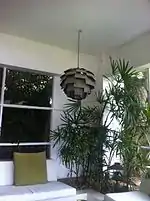 Lunuganga, interior of Bawa's house
Lunuganga, interior of Bawa's house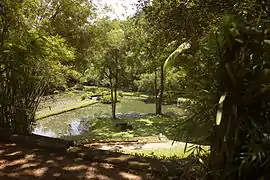 Lunuganga, exterior of Bawa's house.
Lunuganga, exterior of Bawa's house.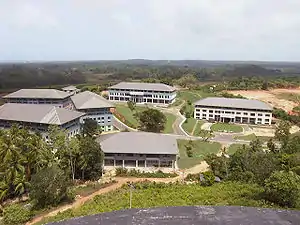 University of Ruhuna
University of Ruhuna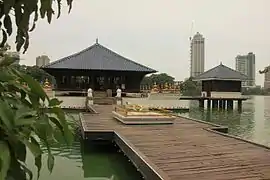 Seema Malaka
Seema Malaka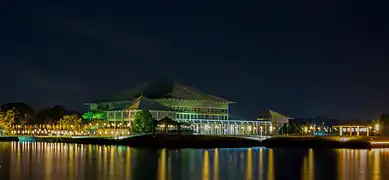 Parliament of Sri Lanka
Parliament of Sri Lanka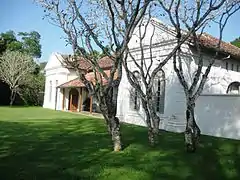 Sunethra Bandaranaike House
Sunethra Bandaranaike House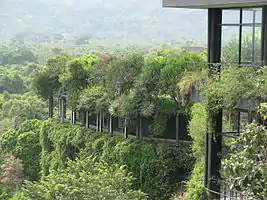 Heritance Kandalama Hotel
Heritance Kandalama Hotel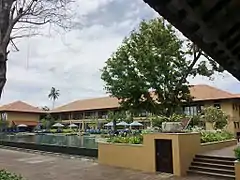 Anantara Kalutara Resort
Anantara Kalutara Resort
Awards and fellowships
- Pan Pacific Citation, Hawaii Chapter of the American Institute of Architects (1967)
- President, Sri Lanka Institute of Architects (1969)
- Inaugural Gold Medal at the Silver Jubilee Celebration of the Sri Lanka Institute of Architects (1982)
- Heritage Award of Recognition, for “Outstanding Architectural Design in the Tradition of Local Vernacular Architecture”, for the new Parliamentary Complex at Sri Jayawardenepura, Kotte from the Pacific Area Travel Association. (1983)
- Fellow of the Royal Institute of British Architects
- Elected Honorary Fellow of the American Institute of Architects (1983)
- Conferred title of Vidya Jothi (Light of Science) in the Inaugural Honours List of the President of Sri Lanka (1985)[27]
- Teaching Fellowship at the Aga Khan Programme for Architecture, at MIT, Boston, USA (1986)
- Conferred title Deshamanya (Pride of the Nation) in the Honours List of the President Sri Lanka (1993)[27]
- The Grate Master's Award 1996 incorporating South Asian Architecture Award (1996)
- The Architect of the Year Award, India (1996)[28]
- Asian Innovations Award, Bronze Award – Architecture, Far Eastern Economic Review (1998)
- The Chairman's Award of the Aga Khan Award for Architecture in recognition of a lifetime's achievement in and contribution to the field of architecture (2001)[29]
- Awarded Doctor of Science (Honoris Causa), University of Ruhuna (14 September 2002)
References
- Aesthetic Recollections Archived 18 November 2007 at the Wayback Machine Newindpress on Sunday
- Beyond vernacular kitsch? The Sunday Times Online
- Legacy of a master The Sunday Times Online
- Green, Jonathan (1 April 2017). "Design Icons: Geoffrey Bawa". ABC Australia National Radio.
- Sennott, Stephen, ed. (2004). Encyclopedia of Twentieth Century Architecture – Volume 1. Taylor & Francis. p. 123-125. ISBN 9781579584337.
- Simpson, Joe (5 March 2006). "Preserving the Spirit of a Forgotten World – Anecdotal glimpses of the New Oriental Hotel, Galle Fort". LankaLIbrary.com. Retrieved 20 October 2014.
- Bawa, Bevis (1985). Briefly by Bevis. Sapumal Foundation.
- Seneviratne, Gamini (26 April 2009). "Bevis Bawa". The Island. Retrieved 7 July 2020.
- Robson, David (30 May 2003). "Geoffrey Bawa". The Guardian. London. Retrieved 20 August 2011.
- "Geoffrey Bawa". ArchNet. Archived from the original on 28 August 2010. Retrieved 20 August 2011.
- Aldrich, Robert Cultural Encounters and Homoeroticism in Sri Lanka: Sex and Serendipity, Routledge, 2014, pp66-79, 123–134
- Aldrich, Robert Cultural Encounters and Homoeroticism in Sri Lanka: Sex and Serendipity, Routledge, 2014, p125
- Robson, David (29 May 2003). "Geoffrey Bawa Obituary". The Guardian.
- Ulrik Plesner: In Situ. An architectural memoir from Sri Lanka. Aristo Publishing, 2013, 451 pages, illustrated.
- Hunn, Patrick. "The 'Australian architect behind some of Asia's most innovative buildings,' Kerry Hill, dies aged 75". ArchitectureAU. Architecture Media Pty Ltd. Retrieved 2 September 2018.
- "Paradise Road Gallery Cafe". 2020. Retrieved 29 September 2020.
- "Remembering Bawa". ArchDaily.
- "Remembering Bawa". ArchDaily.
- "Remembering Bawa". ArchDaily.
- "Remembering Bawa". ArchDaily.
- "Remembering Bawa". ArchDaily.
- Shahpuri, Raveena. "Where to stay in Sri Lanka in under Rs 7,000" (May 30, 2017). Vogue India.
- "Remembering Bawa". ArchDaily.
- "Remembering Bawa". ArchDaily.
- Ancheri, Saumya (13 August 2018). "A design-lover's guide to Sri Lanka". Conde Nast Traveller.
- "Anantara Kalutara , One of Geoffrey Bawa's final projects"
- "National Awards". President of Sri Lanka Secretariat. Retrieved 18 February 2017.
- Kumar, S (Ed) (1999). "Journal of the Indian Institute of Architects". 64. Indian Institute of Architects: 153. Cite journal requires
|journal=(help)CS1 maint: extra text: authors list (link) - Bloom, Jonathon (Ed) (14 May 2009). The Grove Encyclopedia of Islamic Art and Architecture. Oxford University Press. p. 28. ISBN 9780195309911.CS1 maint: extra text: authors list (link)
Further reading
- Aldrich, Robert (2014). Cultural Encounters and Homoeroticism in Sri Lanka: Sex and Serendipity (Hardback). Routledge. ISBN 978-0-41574-236-8.
- Robson, David (2019). Bawa Staircases (Hardback). Talisman Publishing. ISBN 978-9-81118-574-8.
- Robson, David (2002). Geoffrey Bawa: The Complete Works (Hardback). London: Thames & Hudson. ISBN 978-0-50034-187-2.
External links
- Official website
- Remembering Bawa
- Geoffrey Bawa architecture travel guide on www.checkonsite.com
- Architectural Digest: Inside the Sri Lankan Architecture of Geoffrey Bawa. The incredible work getting the world’s attention
- Disappearing Bawa
- Various articles and links about Geoffrey Bawa on www.suravi.fr
